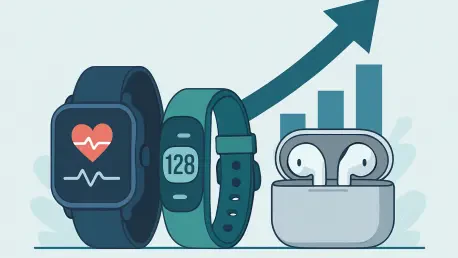Wearable technology has evolved from a niche curiosity into a transformative force, with the market projected to soar from a valuation of $66.10 billion in 2023 to an impressive $344.25 billion by 2032, reflecting a robust compound annual growth rate (CAGR) of 20.2%. This remarkable trajectory is not just a numbers game; it represents a seismic shift in how technology integrates into everyday life. Devices such as smartwatches, fitness trackers, and augmented reality headsets are becoming indispensable tools for health monitoring, productivity, and entertainment. The driving forces behind this growth span from consumer demand for wellness solutions to groundbreaking innovations that expand the scope of these gadgets. As industries and individuals alike embrace wearables, the question arises: what specific trends and advancements are propelling this industry toward such a staggering milestone?
Market Drivers and Consumer Trends
Health and Wellness Focus
The surge in wearable technology adoption is largely fueled by a societal shift toward health consciousness, where individuals increasingly rely on devices to monitor vital metrics like heart rate, sleep quality, and physical activity. Smartwatches and fitness trackers have become personal health companions, offering real-time data that empowers users to make informed lifestyle choices. Beyond mere tracking, these tools are integrating with telehealth platforms, enabling remote consultations with healthcare providers and fostering a proactive approach to wellness. This convergence of personal tech and medical oversight is a cornerstone of the market’s expansion, as it bridges the gap between daily habits and clinical care, making wearables a vital part of modern health management systems.
Another dimension of this trend is the growing acceptance of wearables as legitimate health tools, spurred by regulatory advancements and consumer trust. Features like stress level assessments and blood oxygen monitoring are no longer seen as gimmicks but as essential functionalities, especially in a world prioritizing preventive care. The ability of these devices to provide actionable insights is driving their penetration across diverse demographics, from fitness enthusiasts to older adults seeking to manage chronic conditions. This widespread appeal underscores why health and wellness remain a primary engine for the industry’s projected growth to $344.25 billion by 2032, as more people invest in tech that supports a healthier life.
Enterprise and Industrial Adoption
Wearable technology is transcending its consumer roots, finding substantial footing in enterprise and industrial environments where efficiency and safety are paramount. In healthcare, devices are revolutionizing remote patient monitoring, allowing medical professionals to track vital signs without in-person visits, thus reducing costs and improving outcomes. Similarly, in logistics and manufacturing, wearables equipped with sensors are enhancing operational workflows by providing real-time data on worker movements and equipment status. This adoption is not just a trend but a strategic shift, as businesses recognize the value of integrating such technology to streamline processes and boost productivity in competitive markets.
Beyond healthcare and logistics, wearables are also making inroads into employee training and safety protocols across various sectors. Head-mounted displays (HMDs) powered by augmented reality are being used for immersive training simulations, cutting down on traditional learning curves and enhancing skill acquisition. Meanwhile, wearable sensors in industrial settings help monitor environmental hazards, alerting workers to potential dangers instantly. This versatility in non-consumer applications highlights a significant growth area for the market, as enterprises invest heavily in solutions that promise both innovation and tangible returns, further propelling the industry toward its ambitious financial target over the coming years.
Technological Innovations Fueling Growth
IoT and Connectivity Advancements
The integration of the Internet of Things (IoT) with wearable technology marks a pivotal advancement, enabling devices to communicate seamlessly and operate independently of companion smartphones. With connectivity solutions like Bluetooth Low Energy (BLE) 5.2 and high-speed 4G/5G networks, wearables are achieving low-power, long-range functionality that transforms their utility. This means a smartwatch can now send emergency alerts or stream health data directly to a cloud server without relying on nearby devices. Such capabilities are expanding the scope of wearables into critical areas like personal safety, remote healthcare, and even military operations, where real-time data transmission is non-negotiable, thus driving market growth at an unprecedented pace.
Another layer of this technological evolution is the role of IoT in creating interconnected ecosystems that enhance user experience and functionality. Wearables are no longer standalone gadgets but part of a broader network that includes smart home devices, medical systems, and industrial tools. This interconnectedness allows for sophisticated applications, such as automated health alerts synced with emergency services or industrial wearables optimizing supply chain logistics through live data feeds. As connectivity standards continue to advance, the potential for wearables to penetrate new markets and applications grows, positioning this technological synergy as a key factor in achieving the projected market value of $344.25 billion by 2032.
Product and Segment Evolution
Fitness trackers currently hold a commanding 37% market share, driven by continuous improvements in biometric monitoring and extended battery life from leading brands. These devices have become synonymous with personal fitness goals, offering detailed insights into daily activity levels and health metrics that resonate with a wide audience. Their dominance is a testament to consumer demand for accessible, user-friendly tech that supports wellness without complexity. As innovations refine accuracy and add features like electrocardiogram (ECG) capabilities, this segment remains a bedrock of the wearable market, contributing significantly to its upward financial trajectory over the forecast period.
On the other hand, head-mounted displays (HMDs) are emerging as the fastest-growing segment, with a projected CAGR of 21.7%, fueled by advancements in augmented reality (AR) and virtual reality (VR) technologies. These devices are expanding beyond gaming into professional realms such as training, design, and remote collaboration, offering immersive experiences that redefine interaction with digital content. Simultaneously, the rise of 5G-enabled wearables, growing at a CAGR of 21.9%, caters to the demand for standalone functionality, allowing devices to perform complex tasks independently. This dual momentum in product innovation and connectivity evolution underscores the diverse pathways through which wearable tech is set to achieve its monumental market valuation in the coming years.
Regional Dynamics and Opportunities
North America’s Dominance
North America stands at the forefront of the wearable tech market, commanding a 38% share of global revenue, thanks to its advanced digital infrastructure and substantial consumer spending on premium brands. The region’s leadership is particularly evident in the U.S., where the market is expected to expand from $17.69 billion in 2023 to $78.99 billion by 2032, reflecting a steady CAGR of 18.15%. This growth is driven by cutting-edge innovations in health tech, such as AI-powered analytics for personalized wellness insights, alongside robust adoption in clinical settings for remote patient monitoring. The presence of tech giants and favorable digital health regulations further solidify North America’s position as a hub for wearable advancements.
Additionally, the region benefits from a culture that readily embraces technological trends, supported by high disposable incomes and widespread access to smart devices. Research and development activities thrive here, with companies continuously pushing the envelope on wearable functionalities, from smart apparel to sophisticated health trackers. This environment of innovation and consumer readiness ensures that North America not only maintains its revenue lead but also sets global standards for wearable tech adoption, playing a crucial role in steering the market toward its projected $344.25 billion milestone by 2032.
Asia-Pacific’s Rapid Rise
The Asia-Pacific region is carving out its place as the fastest-growing market for wearable technology, with an anticipated CAGR of 22%, driven by escalating disposable incomes and deepening smartphone penetration. Countries like China, India, and Japan are at the forefront, where digital health initiatives and smart city projects are accelerating the adoption of wearables among vast populations. This demographic advantage, combined with a burgeoning middle class eager for tech-driven lifestyle solutions, positions the region as a critical growth engine, capable of significantly influencing global market dynamics over the forecast period.
Moreover, the region’s rapid economic development is fostering an environment ripe for technological integration, with local and international brands tailoring affordable, feature-rich wearables to meet diverse consumer needs. Government policies supporting digital transformation and healthcare accessibility further amplify this trend, encouraging the use of wearables for everything from fitness tracking to chronic disease management. As Asia-Pacific continues to harness these economic and technological tailwinds, its contribution to the wearable tech market’s journey to $344.25 billion by 2032 becomes increasingly indispensable, highlighting a shift in global market balance toward emerging economies.









